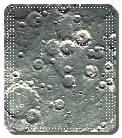
Mercury was visited by the Mariner 10 mission, in 1974. A unique opportunity presented itself in 1973 to send a spacecraft to visit both Venus and Mercury in a single mission, using gravity assist, a technique theorized for decades but never used before. At the time, few was known about Mercury as a direct flight to there would have required a large and expensive rocket due to the extra fuel needed to reach the planet. The gravity-assist technique thus provided an opportunity for the first spacecraft-based observations Mercury! In 1969, NASA approved a mission, first known as Mariner Venus Mercury, and later renamed Mariner 10 and managed by the Jet Propulsion Laboratory in Pasadena, California. It was the last in the Mariner series of very successful spacecraft that revealed many secrets about the inner solar system. The 1,100-lbs Mariner 10 lifted off on Nov. 3, 1973, aboard its Atlas/Centaur D1-A rocket from Launch Pad 36B at Cape Canaveral, Florida. After a short time in a parking orbit around the Earth, the Centaur stage reignited, sending Mariner 10 toward Venus. Mariner 10 used Canopus as a guide-star. During its first week in space, the spacecraft calibrated its camera system by taking photographs of the Earth and Moon, including of the Moon’s north polar region that was poorly imaged by earlier spacecraft. The three-month cruise to Venus had the Mariner, in January 1974, make ultraviolet observations of Comet Kohoutek, adding to observations by ground-based observatories as well as the astronauts aboard the Skylab space station in Earth orbit. To accomplish its goals, Mariner 10 carried six scientific instruments – the Television Photography System consisting of two telescopes to image the planets; an infrared radiometer to calculate the temperature of Venus’ atmosphere and Mercury’s surface; an ultraviolet spectrometer primarily to detect any atmosphere around Mercury; plasma detectors to study the solar wind inside the orbit of Venus for the first time; a charged particle telescope to study cosmic radiation; and magnetometers to detect any magnetic field around Mercury. In addition, as the spacecraft passed behind the planet, its radio signals were used to probe Mercury’s atmosphere and precisely measure its radius. By precisely tracking the spacecraft’s trajectory as it passed Mercury, its mass and gravitational characteristics could be determined. Mercury was the first craft ever to use a gravity-assist flyby as a way to make its way to its target. The spacecraft flew by at Venus on February 5, 1974, 17:01 UT, by 3,600 mi (5,768 km) and made science there. Its trajectory was boosted and at the same time re-directed to Mercury. The inner planet was now 43 days ahead! After some troubleshooting about the trajectory and the craft attitude, Mercury eventually was acquired by Mariner 10's optics beginning on March 23rd, 1974. These first pictures, taken from 3.3 million mi (5.3 million km), were about the quality of what had been taken until now from ground-based observatories. As the elusive planet had always been so difficult to observe from Earth -as it never ventures far from the horizon as evening or morning star- the pictures which were further beamed by Mariner 10 turned to fantastic, and they soon gave the first accurate images ever of Mercury. During this first flyby Mariner took 2,000 pictures. On March 29, Mariner 10 passed only 438 miles (704km) above Mercury's surface and continued to photograph the planet until April 3, by which time it had returned more than 2,000 images as well as a wealth of data from its other scientific instruments. At first glance, Mercury appeared very Moon-like with a heavily cratered surface, but overall the planet's surface features showed less contrast than our satellite. Other features such as scarps or cliffs present on Mercury are absent on the Moon and hint at the planet's formation. Mercury also has mare or flat plain like features like the Moon and Mars, possible clues to similar planetary ancestries in terms of bombardment by asteroids. Somewhat surprisingly, Mariner 10's magnetometer detected a weak (about 1/60th the strength of Earth's) magnetic field. Radio tracking of the spacecraft's trajectory revealed Mercury to be much closer to being a perfect sphere than Earth. The large temperature difference between Mercury's day and night sides, more than 600 degree F, indicates that its surface is composed of similar material to the Moon's, a blanket of dust pulverized by meteoric impacts. Five mid-course corrections were required to properly aim the spacecraft for its second encounter and also enable the third. On Sep. 21, 1974, it passed at a more distant 29,875 miles (48000km) of Mercury's sunlit side and this trajectory allowed the planet's south polar region to be observed. Some 500 new images of the planet were returned during the three-day encounter, and the greater distance of the flyby allowed scientists to create a series of hemisphere-wide mosaics of amazing detail. The spacecraft's ultraviolet spectrometer confirmed that Mercury has a very thin atmosphere composed mainly of helium. The third encounter took place on March 16, 1975. Mariner 10, already running low on attitude control fuel, rolled out of communication with Earth. Controllers scrambled to get time on tracking antennas to regain control of the spacecraft and succeeded just in time for the encounter. This time the fly-by distance was only 203 miles (326km) above the surface, with the main goals to study the planet's magnetic field and to take more detailed imagery of sites of interest identified from the first two encounters. About 450 useful narrow strips of photographs were taken, some with a surface resolution down to about 450 feet (137m). Eight days later, Mariner 10 depleted its attitude control fuel and mission controllers sent a signal to turn the spacecraft off
 | Mercury at first flyby. courtes3 NASA/JPL/U.S. Geological Survey |
>Mission planners had chosen the trajectory in such a way that the encounter with Mercury would occur when the planet was at its furthest point from the Sun in its elliptical orbit so that Mariner 10 would not have to travel any closer to the Sun than necessary to reduce the risk of overheating. Another premiere was that Mercury was not to just graze its target-planet but it was to somehow orbit around it. Italian scientist and mathematician Giuseppe Colombo (1920-1984) from the University of Padua calculated that Mariner 10’s trajectory would make it possible to revisit Mercury every six months, with the spacecraft making one revolution around the Sun and Mercury making two during the interim. Two further encounters with Mercury were scheduled. Mariner's orbits were in fact heliocentric orbits, as their aphelion was taking the craft back up to the orbit of Venus, with the probe plunging back to Mercury. Interestingly, the trajectories had been computed in such a way that, at each of its orbit back to the planet, the craft came back at an angle similiar to the one with which it had first met Mercury. As the first flyby had occurred at an altitude of 437 mi (704 km) on March 29th, 1974, the second (September 21st, 1974) and the third (March 16, 1975) however were performed at 29,875 mi (48,069 km) and 200 mi (327 km) respectively. These additional flybys allowed more pictures and more science. The downside to this timing was that every time Mariner 10 returned to the planet, the planet presented the same sunlit hemisphere for observation. Thus only about 40-45 percent of the planet's surface was imaged, but at high enough resolution to generate a detailed map
 | a 7,500 ft high scarp at Mercury. courtesy NASA/JPL/Northwestern University |
Mariner 10 is the craft which brought a still unsurpassed wealth of science about Mercury. Next step will surely be in 2008-2011 when the NASA Messenger mission, which left Earth in August 2004, will reach there for a comprehensive study. Mariner 10 took about 12,000 pictures, mapping about 45 percent of the planet. Due to the particular geometry of its encounters with Mercury -the closest graze occurring at the night side, the probe's camera had been fitted with a 1,500-mm lens to allow for detailed pictures during the approach and exit phases. The second pass, as far as it is concerned, occurred under the South pole of Mercury. On the other hand, infrared thermal measurements gave views about the soils, ultraviolet spectrography provided data about the atmosphere, as the mass and gravitational characteristics of Mercury were better determined. Another important discovery was that of a magnetic field and of a magnetosphere, as the magnetic field was offset, with likely various levels of the surface having some different levels of protection. Mercury was ultimately revealed by Mariner 10! It's now seen like a moonlike, heavily cratered planet, with scarps, faults, and circular basins. It might that the large scarps and faults might have been driven by an iron core cooling over billions of years as water ice might exist deep inside polar craters where, in the shadow, temperatures could drop below -212° C (-350° F), compared to the inferno 400° C (750°) in full lighted areas. Before the Mariner 10, the radar at Arecibo in Puerto Rico found what could be a signature or water or water ice, narrowed down to specific areas on the poles as the mission showed that there were craters indeed matching the emissions there. Just eight days after this last encounter of Mercury, Mariner 10 exhausted its supply of attitude control gas and ground controllers turned off its transmitter. The silent spacecraft sailed on in solar orbit
Website Manager: G. Guichard, site 'Amateur Astronomy,' http://stars5.6te.net. Page Editor: G. Guichard. last edited: 4/8/2019. contact us at ggwebsites@outlook.com